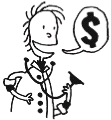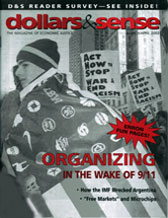
Dear Dr. Dollar:
The Federal Reserve keeps fussing with the “discount rate” and everybody thinks it’s important. This is, if I understand it right, the rate banks charge each other for overnight loans. Now presumably someone makes money on the interest that’s charged and someone loses money (or makes less) when the rate is lowered. But no one screams. Why not? If it’s because the charges among banks just cancel one another out, then why does the rate even matter? Or is it that the Federal Reserve itself charges this interest, in which case the taxpayers lose when the rate it lowered?
—Peter Marcuse, New York, NY
This article is from the March/April 2002 issue of Dollars and Sense: The Magazine of Economic Justice available at http://www.dollarsandsense.org

This article is from the March/April 2002 issue of Dollars & Sense magazine.
Subscribe Now
at a discount.
To answer your question, it helps to understand how the U.S. Federal Reserve system works. The quasi-public Federal Reserve has two parts, neither of which is actually part of the federal government. First, there are the district banks—12 Federal Reserve Banks scattered across the country, charged with regulating and overseeing the commercial banks in their region and each wholly owned by those banks. Then there is the Board of Governors, a seven-member board with a vast research staff, based in Washington, D.C., and chaired by Alan Greenspan.
Every six weeks, the board and the presidents of the regional banks meet together as the so-called Federal Open Market Committee (FOMC), where they set targets for the fed funds rate—a rate that commercial banks charge one another for overnight loans. After the fed funds target is announced, the district banks will generally raise or lower the discount rate—the rate that commercial banks pay when they borrow from their local Fed—so that the two rates stay roughly equal.
In order to reduce the fed funds rate, the FOMC directs traders at the New York Federal Reserve Bank to buy U.S. Treasury bills on the financial markets. The Fed creates new money—quite literally, since paper printed by the Fed is money—to pay for these bills. When this new money enters the economy, it tends to be deposited in banks that, suddenly awash in cash, must find borrowers for it if they are to earn a profit. (To raise interest rates the FOMC does the opposite, selling U.S. Treasury bills and taking cash out of circulation.)
Since the district banks are owned not by the federal government but by the commercial banks, reductions in the discount rate do not affect the public treasury. And since commercial banks are both borrowers and the lenders in the fed funds market, gains and losses for the banks do tend, as you suspect, to cancel out. The point of reducing the fed funds rate, though, is to drive down other interest rates. If the financial markets are swimming in cheap cash, then competition for borrowers ought to push down rates on auto loans, business loans, mortgages, rates on bonds, and so forth.
Financial firms earn money by charging interest. In general, they prefer high interest rates to low. But they prefer low interest rates to watching their business dry up and their clients default on loans. Banks recognize that in a recession, lower interest rates may be necessary to spur growth and prevent bankruptcies. They accept the Fed’s authority to reduce rates and print new money when circumstances warrant it. And they also know that the Fed, traditionally, has been their advocate—if not their mouthpiece—in Washington.
The district banks are owned outright by the finance industry and appointees to the Board of Governors nearly always have close industry ties. Greenspan himself has a well-established record as an “inflation hawk” who tends to err on the side of high interest rates. Moreover, in his nearly 12 years as Fed chair, Greenspan has presided over the slow erosion of the Fed’s policy authority, so that a lower fed funds rate often does not translate into lower interest rates for businesses and consumers. Over the past year, for example, the FOMC cut its target fed funds rate from 6.0% to 1.75%, yet rates on home mortgages have fallen by only one percentage point. If the Fed really wanted to bring down long-term interest rates (like mortgage rates), it could sell not only short-term Treasury bills but also long-term bonds. The Fed could use a variety of other means to lower interest rates set in other markets (like the bond market), but such policies could eat into the finance industry’s earnings. Instead, the Fed’s recent interest rate reductions have meant that banks pay lower rates on deposits, while earning fairly high rates on loans to consumers and businesses.
If the recession persists and competition for credit-worthy customers intensifies, however, lending rates will fall and banks will feel the pinch of the Fed’s cheap credit policy. But don’t expect to see Citigroup lambasting the Fed on the New York Times editorial page or lobbying Congress to oust Greenspan. The banks have a more direct avenue for airing their complaints. Every six weeks, on the day before the FOMC meets to set interest rate policy, the Board meets with the Federal Advisory Council—a group of private bankers from each of the 12 Fed districts—to hear their advice on how high interest rates should be.
Economist Edwin Dickens from Drew University, who has done extensive archival research on the Fed, notes that banks often “are adamant that they can’t take the hit in income” if the Fed cuts rates. Records show that they have often thwarted rate cuts, even in recessions. So if lowered rates begin to squeeze financial earnings, the finance industry won’t scream. Who needs to scream when you can whisper?
Did you find this article useful? Please consider supporting our work by donating or subscribing.
